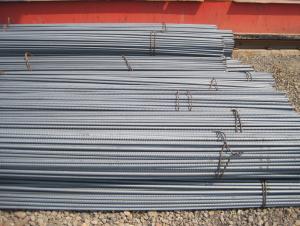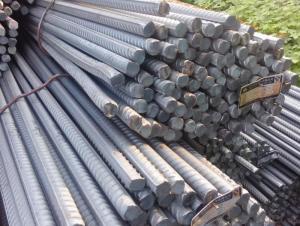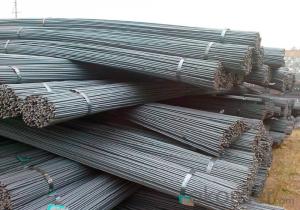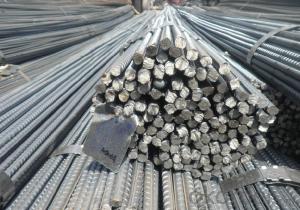HRB500 Deformed Steel Bar /Steel Rebars
- Loading Port:
- China main port
- Payment Terms:
- TT OR LC
- Min Order Qty:
- 100 m.t.
- Supply Capability:
- 100000 m.t./month
OKorder Service Pledge
OKorder Financial Service
You Might Also Like
Item specifice
HRB500 Deformed Steel Bar /Steel Rebars
Specifications
Standard: ASTM, GB, JIS, BS, AISI
Grade: HRB400, HRB335, HRB500, GR60
Length:6m, 9m,12m
Diameter: 8-40mm
Product Description
Type | steel rebar |
Standard Grade | a. GB1499.2-2007, HRB335, HRB400, etc. |
b. ASTM A615 Gr.40, Gr.60, etc. | |
c. BS4449, etc. d. JISG3112-SD390 | |
Diameter | 6mm-32mm etc. as per customers' requirement |
Length | 6m, 8m, 9m,12m as standard |
Application | Construction, shipping, building material |
Packing | standard export packing, or as per customers' requirement |
Quality | First quality |
Delivery time | Right now after the deposit. |
Others | 1. our products conform to all the standards |
2. we can offer special specification products as per our customers | |
3. we can offer the original mill test certificate and original product |
Physical Property-HRB500
Dia (mm) | Length(m) | Chemical composition (%) | Yield Strength(N/cm2) | Tensile Strength(N/cm2) | Elongation (%) | Benden 180° 3d | ||||
C | Mn | Si | S | P | MPa | |||||
Ø12 | 12 | 0.24 | 1.35 | 0.52 | 0.024 | 0.027 | 530 | 660 | 14 | OK |
Products
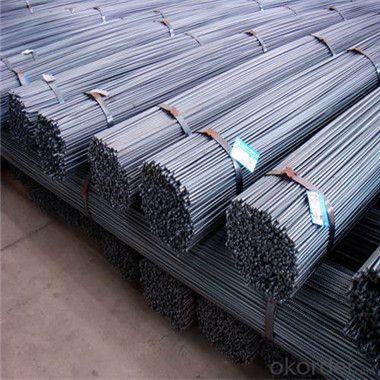

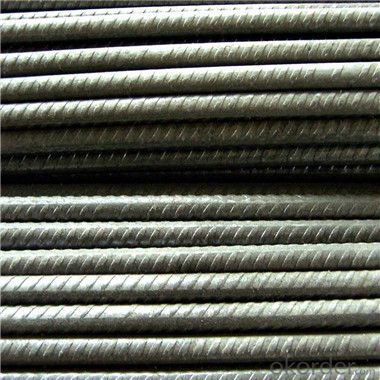

- Q:How do steel rebars affect the constructability of a project?
- Steel rebars play a crucial role in enhancing the constructability of a project in several ways. Firstly, they provide structural strength and stability to reinforced concrete structures. By reinforcing the concrete, rebars help to distribute the load more evenly, increasing the overall strength and durability of the project. Secondly, steel rebars allow for the construction of larger and taller structures. They provide the necessary tensile strength to counteract the concrete's weakness in resisting tension forces. This enables engineers and architects to design and build structures with greater flexibility, leading to more innovative and impressive architectural designs. Moreover, steel rebars help to ensure the integrity and safety of a project. They act as a reinforcement against external forces such as earthquakes, wind loads, and impacts. By resisting these forces, they enhance the structural stability, reducing the risk of collapse or damage during extreme conditions. Steel rebars also contribute to the longevity and maintenance of the project. Due to their high tensile strength and resistance to corrosion, they help extend the lifespan of the structure. This reduces the need for frequent repairs and replacements, resulting in cost savings and less disruption to the project. Furthermore, the use of steel rebars simplifies the construction process. They can be easily cut, bent, and shaped to fit the required specifications, making them highly adaptable to various project requirements. This flexibility allows for efficient construction, reducing the time and effort required for implementation. Overall, steel rebars significantly impact the constructability of a project by providing strength, stability, flexibility, safety, longevity, and simplification. Their use enables the construction of robust and aesthetically pleasing structures, ensuring the success and sustainability of the project.
- Q:What are the different types of steel rebars used in railway bridges?
- There are several types of steel rebars used in railway bridges, including plain carbon steel rebars, epoxy-coated rebars, and stainless steel rebars. Each type of rebar offers unique properties and benefits to ensure the durability and strength of railway bridges.
- Q:The difference between rebar and crescent
- The thread and Crescent are 45 degrees diagonally raised, the thread is straight, crescent shaped arc, like a watermelon rind.
- Q:Can steel rebars be used in the construction of shopping centers?
- Yes, steel rebars can be used in the construction of shopping centers. Steel rebars are commonly used in reinforced concrete structures, including commercial buildings like shopping centers, as they provide strength, durability, and resistance to structural forces.
- Q:What are the factors to consider while designing a reinforced concrete structure with steel rebars?
- To ensure the strength, durability, and safety of a reinforced concrete structure with steel rebars, careful consideration of various factors is required. The following are key factors to consider: 1. Structural Requirements: The initial step involves determining the structure's specific purpose and load-bearing capacity. This entails considering its intended use, maximum load, and potential dynamic loads like wind or earthquakes. 2. Material Selection: Choosing the correct type and grade of concrete and steel rebars is crucial. The concrete mix should possess sufficient strength, workability, and durability to withstand anticipated conditions. Similarly, the rebars should have adequate yield strength and corrosion resistance to maintain structural integrity over time. 3. Reinforcement Layout: The design should include an appropriate arrangement and spacing of rebars to evenly distribute the load and prevent cracking or structural failure. This requires determining the size, quantity, and arrangement of rebars based on calculated forces and bending moments. 4. Concrete Cover: The concrete cover refers to the thickness of concrete surrounding the rebars. Providing sufficient cover is essential to protect the rebars from corrosion, fire, and environmental factors. The cover thickness should be determined based on exposure conditions and required durability. 5. Bonding between Concrete and Rebars: Ensuring proper bonding between the concrete and rebars is vital for effective force transfer. The design should consider factors such as mechanical interlocking, chemical adhesion, and surface treatment to establish a strong bond and prevent slippage or separation. 6. Construction Considerations: The design should account for practical construction aspects such as formwork, concrete placement, and compaction. It should also incorporate appropriate detailing for construction joints, lap splices, and rebar anchorage to ensure proper installation and ease of construction. 7. Serviceability and Durability: The design should address serviceability requirements like deflection limits, cracking control, and long-term performance. Additionally, factors impacting durability, such as moisture exposure, chemical exposure, temperature variations, and the potential for corrosion, should be considered. 8. Quality Control and Inspection: Implementing quality control measures, including material testing, construction monitoring, and completed work inspection, is crucial to ensure the design requirements are met. Regular inspections and adherence to construction standards and codes are essential for the overall integrity and safety of the structure. By considering these factors and adhering to appropriate design codes and standards, a reinforced concrete structure with steel rebars can be designed to provide the desired strength, durability, and safety throughout its lifespan.
- Q:Are steel rebars suitable for use in structures with high impact resistance requirements?
- Yes, steel rebars are suitable for use in structures with high impact resistance requirements. Steel rebars are known for their high tensile strength and durability, making them ideal for reinforcing concrete structures that need to withstand heavy impacts. They provide additional strength and stability to the construction, ensuring the structure can withstand various external forces and impacts without compromising its integrity.
- Q:What is the length and size of thread steel?
- Steel is known as hot rolled ribbed bar.Specification requirements for threaded steel shall be specified in the import and export trade contract. Generally should include the standard grade (type code), the nominal diameter of steel, nominal weight (quality), the length of the specifications and the allowable difference between the above indicators.
- Q:What's the difference between primary and two grade steel and three grade steel?
- There are two levels of steel rebar, three steel, four steel grade difference, no grade steel, there are a lot of customers to wire (round) mistakenly called a steel. At present, China is gradually out of grade two steel, four steel grade two steel grade HRB335, three grade steel grade HRB400, four grade of steel wire is HRB500, (Pan Yuan) new material grades are HPB195, HPB235, HPB300, old wire material grades corresponding is Q195, Q235.
- Q:How do steel rebars affect the overall crack width of concrete structures?
- The crack width of concrete structures is affected by steel rebars in various ways. Primarily, the reinforcement provided by rebars strengthens the concrete, increasing its resistance to cracking. This reinforcement helps distribute the tensile forces within the concrete, preventing cracks from spreading and widening. When the concrete is subjected to tensile stress, the rebars bear a significant portion of the load, reducing stress on the concrete itself and minimizing crack formation. Furthermore, the use of rebars influences the spacing and size of cracks in concrete structures. Engineers can control the crack width by incorporating rebars at specific intervals and in appropriate sizes. The rebars act as barriers that limit crack width by resisting the tensile forces exerted on the concrete. This is especially important in structures exposed to heavy loads or external forces, as it preserves the structural integrity and durability of the concrete. Moreover, steel rebars impact the propagation of cracks in concrete structures. In the event of cracks, rebars prevent their further extension. They serve as anchors, holding the cracked sections of concrete together and preventing crack spread. This is essential for ensuring overall structural stability and reducing the risk of structural failure. To summarize, steel rebars play a crucial role in influencing the overall crack width of concrete structures. They enhance concrete strength, distribute tensile forces, regulate crack spacing and size, and inhibit crack propagation. By incorporating rebars into concrete structures, engineers can effectively manage and diminish crack formation and severity, ensuring the longevity and safety of the structures.
- Q:How are steel rebars used in water treatment plants?
- Steel rebars are used in water treatment plants to reinforce the concrete structures, such as tanks and pipelines, that are essential for the treatment and transportation of water. The rebars provide strength and stability to these structures, ensuring their durability and ability to withstand the harsh conditions and pressures involved in the water treatment process.
1. Manufacturer Overview |
|
|---|---|
| Location | |
| Year Established | |
| Annual Output Value | |
| Main Markets | |
| Company Certifications | |
2. Manufacturer Certificates |
|
|---|---|
| a) Certification Name | |
| Range | |
| Reference | |
| Validity Period | |
3. Manufacturer Capability |
|
|---|---|
| a)Trade Capacity | |
| Nearest Port | |
| Export Percentage | |
| No.of Employees in Trade Department | |
| Language Spoken: | |
| b)Factory Information | |
| Factory Size: | |
| No. of Production Lines | |
| Contract Manufacturing | |
| Product Price Range | |
Send your message to us
HRB500 Deformed Steel Bar /Steel Rebars
- Loading Port:
- China main port
- Payment Terms:
- TT OR LC
- Min Order Qty:
- 100 m.t.
- Supply Capability:
- 100000 m.t./month
OKorder Service Pledge
OKorder Financial Service
Similar products
New products
Hot products
Related keywords


